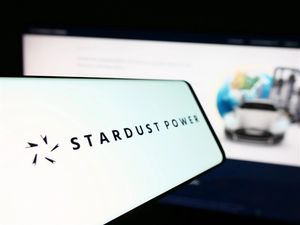
Discount grocery store chain Grocery Outlet (NASDAQ: GO) fell short of the markets revenue expectations in Q3 CY2025, but sales rose 5.4% year on year to $1.17 billion. On the other hand, the company’s outlook for the full year was close to analysts’ estimates with revenue guided to $4.71 billion at the midpoint. Its non-GAAP profit of $0.21 per share was 11.5% above analysts’ consensus estimates.
Is now the time to buy GO? Find out in our full research report (it’s free for active Edge members).
Grocery Outlet (GO) Q3 CY2025 Highlights:
- Revenue: $1.17 billion vs analyst estimates of $1.18 billion (5.4% year-on-year growth, 0.8% miss)
- Adjusted EPS: $0.21 vs analyst estimates of $0.19 (11.5% beat)
- Adjusted EBITDA: $66.67 million vs analyst estimates of $67.47 million (5.7% margin, 1.2% miss)
- The company dropped its revenue guidance for the full year to $4.71 billion at the midpoint from $4.75 billion, a 0.8% decrease
- Management raised its full-year Adjusted EPS guidance to $0.79 at the midpoint, a 1.9% increase
- EBITDA guidance for the full year is $260 million at the midpoint, below analyst estimates of $264.7 million
- Operating Margin: 2%, down from 3.6% in the same quarter last year
- Locations: 563 at quarter end, up from 529 in the same quarter last year
- Same-Store Sales rose 1.2% year on year, in line with the same quarter last year
- Market Capitalization: $1.39 billion
StockStory’s Take
Grocery Outlet’s third quarter results were met with a significant negative market response, as the company missed Wall Street’s revenue expectations and reported a notable year-over-year decline in operating margin. Management attributed the underperformance in same-store sales to late-quarter changes in promotional activity and a less effective marketing mix, which led to a slowdown in customer traffic. CEO Jason Potter described the impact of these decisions as "net negative," and emphasized the company’s focus on course correction, noting, “we’ve seen a return to weekly comp growth” after adjustments to marketing and promotions.
Looking ahead, management’s updated guidance hinges on execution of the store refresh program, enhancements to inventory visibility for independent operators, and a continued focus on cost control. CEO Jason Potter expressed confidence that these strategic initiatives will drive stronger comparable sales growth in the coming year, particularly as refreshed stores show early signs of mid-single-digit sales lifts. However, management acknowledged ongoing uncertainty around external factors such as potential disruptions to SNAP benefits, with CFO Chris Miller stating, “any potential disruption to sales resulting from delayed or missed SNAP benefits due to the ongoing shutdown is not currently factored into our guidance.”
Key Insights from Management’s Remarks
Management identified operational execution, store refresh efforts, and adjustments to marketing as primary drivers of recent performance and future strategy.
- Store refresh pilot results: Early implementation of the store refresh program in select locations produced mid-single-digit same-store sales lifts, driven by improved layouts, expanded core assortments, and clearer in-store value messaging. Management plans to accelerate the rollout, aiming for at least 150 refreshed stores by the end of next year.
- Inventory visibility and system upgrades: The rollout of real-time and arrival order guides has improved independent operators’ ability to manage inventory and maintain in-stock positions, especially in fresh categories like meat and produce. These changes are intended to restore system functionality lost during the SAP implementation and underpin future same-store sales growth.
- Marketing and promotions recalibration: Management acknowledged that recent experiments with promotional activity and marketing mix, particularly a shift toward social media, were less effective and contributed to softer comp store sales. The team has since reverted to more traditional marketing approaches that have driven a return to positive comps.
- Core assortment consistency: The company defined 400 core items to be consistently stocked across all stores, responding to customer feedback for greater reliability in product selection. This initiative is expected to increase basket size and make Grocery Outlet a more viable primary shopping destination.
- Leadership additions: New hires, including a Chief Store Operations Officer from Lidl and a Chief Supply Chain Officer from Target, are expected to enhance operational execution and support supply chain modernization as the company scales its refreshed store model.
Drivers of Future Performance
Management expects the pace and effectiveness of store refresh rollouts, along with cost discipline and inventory tools, to shape next year’s results.
- Store refresh as comp driver: Management believes scaling the store refresh program—focused on merchandising, assortment, and in-store messaging—will be the primary driver for accelerating comparable sales growth in the coming year. Early pilots suggest mid-single-digit comp lifts, though execution speed and consistency across markets will be critical.
- SNAP and macro uncertainty: The company flagged the potential for disruption from federal SNAP (Supplemental Nutrition Assistance Program) benefits, which represent around 9% of sales. Management has not baked in any impact from possible government shutdowns, acknowledging that changes to SNAP funding could quickly affect traffic and sales.
- Cost controls and SG&A leverage: Cost savings initiatives are expected to deliver $15 million to $20 million over the next two years, supporting modest SG&A leverage even as the company invests in merchandising and supply chain capabilities. However, management indicated that comparable sales growth of around 2.5% is needed to achieve meaningful expense leverage.
Catalysts in Upcoming Quarters
In the quarters ahead, our analysts will closely monitor (1) the pace and sales impact of the store refresh rollout across diverse markets, (2) sustained improvements in inventory management and in-stock levels enabled by new order guide tools, and (3) any effects on sales from changes in SNAP benefits or broader macroeconomic pressures. Continued execution on cost discipline and successful integration of new leadership will also be crucial signposts.
Grocery Outlet currently trades at $12.46, down from $14.19 just before the earnings. In the wake of this quarter, is it a buy or sell? The answer lies in our full research report (it’s free for active Edge members).
High Quality Stocks for All Market Conditions
Fresh US-China trade tensions just tanked stocks—but strong bank earnings are fueling a sharp rebound. Don’t miss the bounce.
Don’t let fear keep you from great opportunities and take a look at Top 5 Strong Momentum Stocks for this week. This is a curated list of our High Quality stocks that have generated a market-beating return of 183% over the last five years (as of March 31st 2025).
Stocks that made our list in 2020 include now familiar names such as Nvidia (+1,545% between March 2020 and March 2025) as well as under-the-radar businesses like the once-small-cap company Comfort Systems (+782% five-year return). Find your next big winner with StockStory today.
StockStory is growing and hiring equity analyst and marketing roles. Are you a 0 to 1 builder passionate about the markets and AI? See the open roles here.






